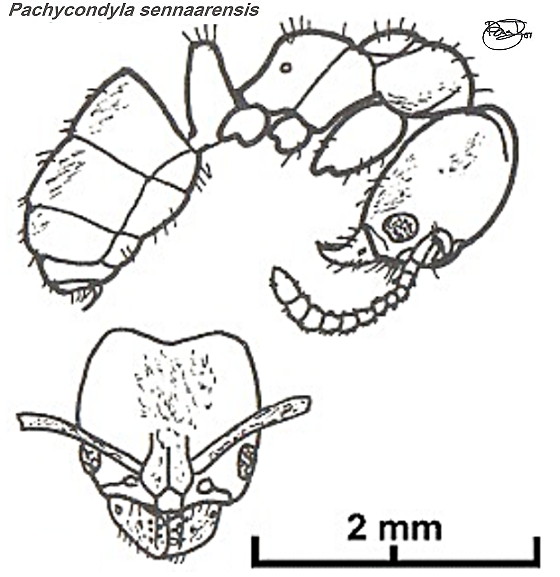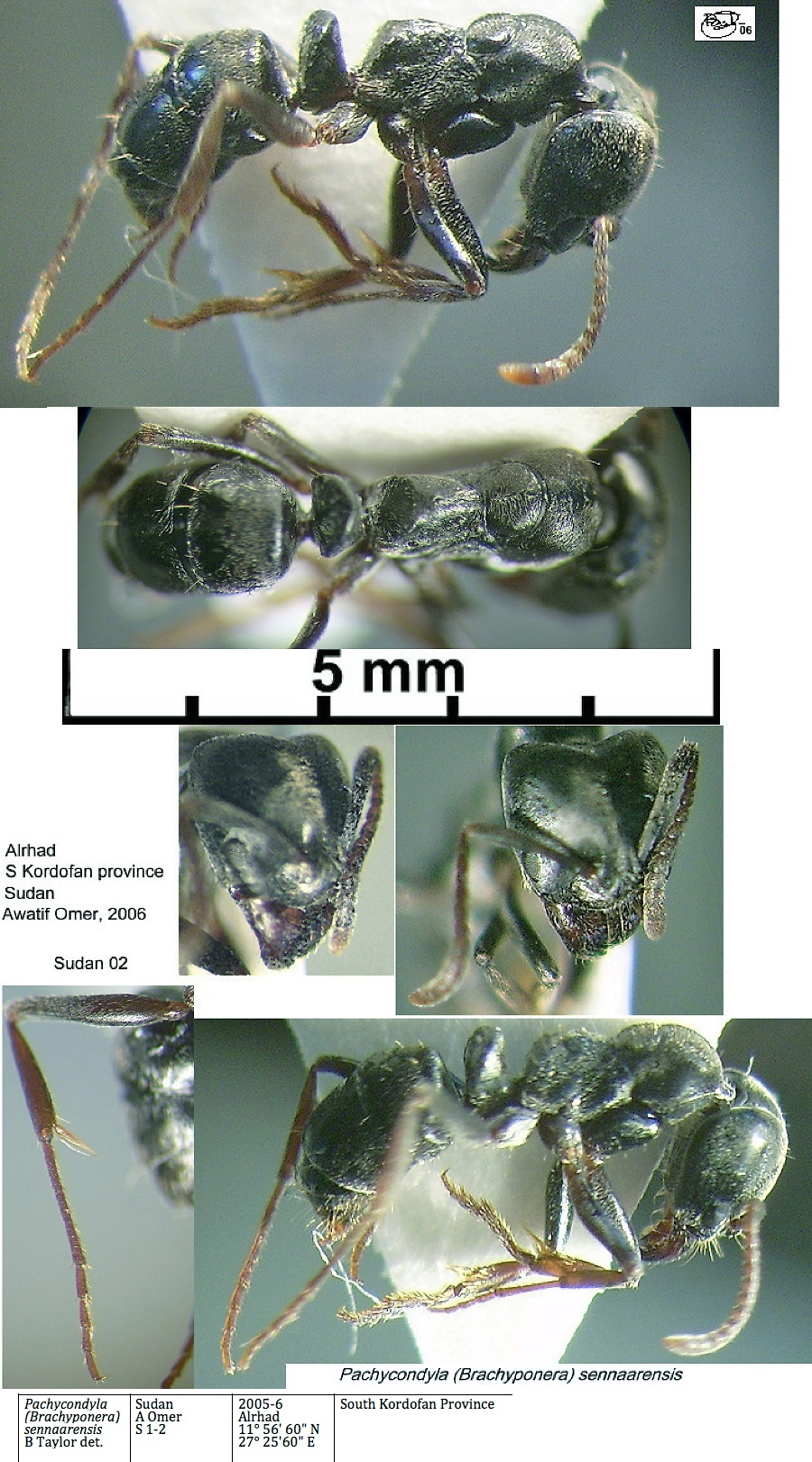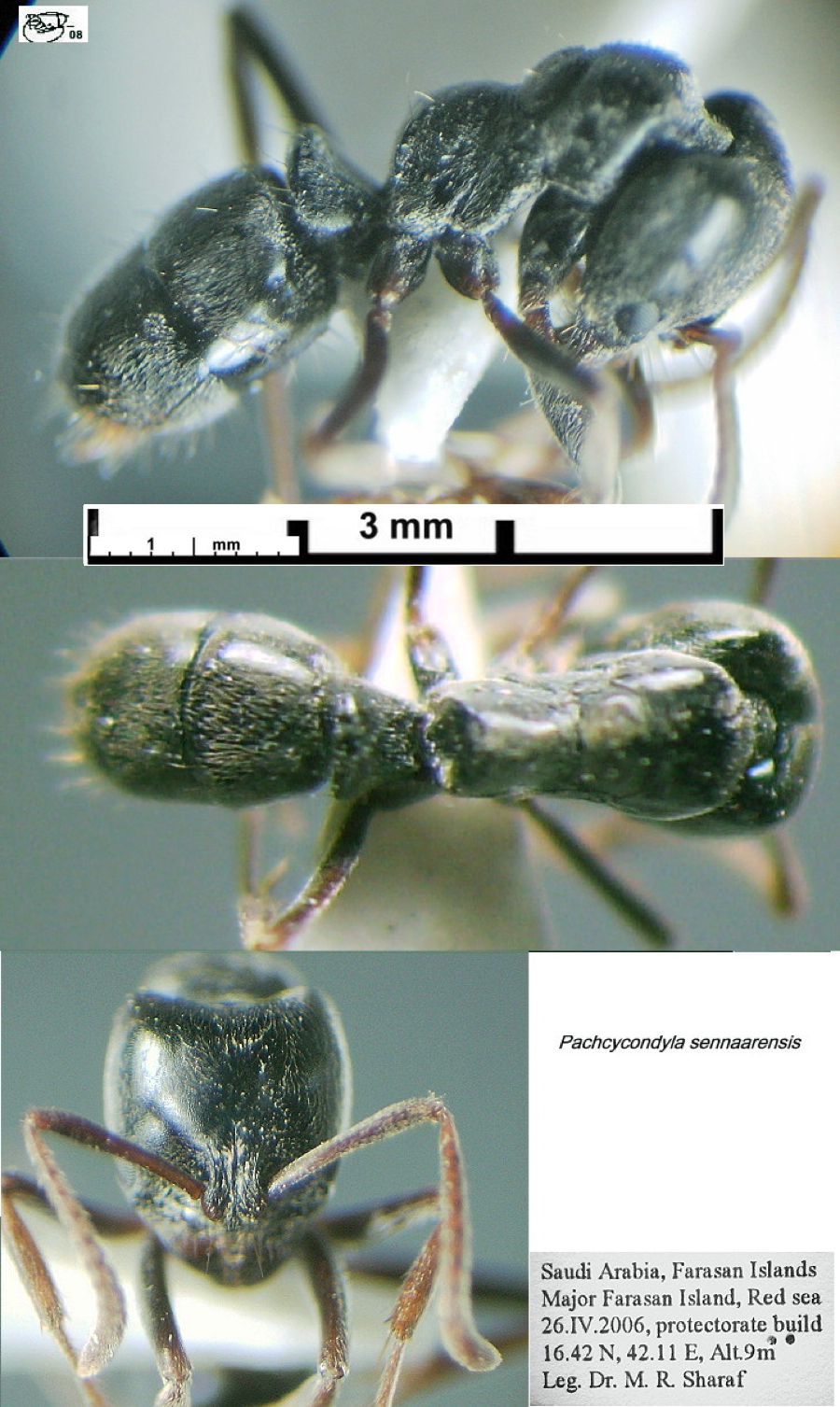Pachycondyla (Brachyponera) sennaarensis (Mayr)
  Type location Sudan (Ponera
sennaarensis, Mayr, 1862: 721, worker; Santschi, 1910c: 350,
Santschi, 1910c: 350, queen reported but not described; Forel, 1910c:
245, male reported but not described) collected at Sennar; subspecies decolor
(Santschi, 1921c: 114, worker) from Senegal, at Ferlo, by
Claveau; and ruginota (Stitz, 1916: 372, worker) from Cameroun,
collected at Yaundé, by von Sommerfeld; junior synonym sorghi (Ponera
sorghi, Roger, 1863a: 169, worker) from Sudan; all forms
known (see Bolton, 1995) Type location Sudan (Ponera
sennaarensis, Mayr, 1862: 721, worker; Santschi, 1910c: 350,
Santschi, 1910c: 350, queen reported but not described; Forel, 1910c:
245, male reported but not described) collected at Sennar; subspecies decolor
(Santschi, 1921c: 114, worker) from Senegal, at Ferlo, by
Claveau; and ruginota (Stitz, 1916: 372, worker) from Cameroun,
collected at Yaundé, by von Sommerfeld; junior synonym sorghi (Ponera
sorghi, Roger, 1863a: 169, worker) from Sudan; all forms
known (see Bolton, 1995)  . .
|
Mayr's (1862) description is at  . Roger's (1863a) description of sorghi
is at . Roger's (1863a) description of sorghi
is at  . Arnold (1915: 72) gave
a translation, this is at . Arnold (1915: 72) gave
a translation, this is at  and, male & queen, and, male & queen,  . Santschi's (1921c)
description of decolor is at . Santschi's (1921c)
description of decolor is at  . .
|
 WORKER - specimens from Nigeria (drawn by me) - TL 5.26,
HL 1.24, HW 1.40, SL 1.09, PW 0.93 WORKER - specimens from Nigeria (drawn by me) - TL 5.26,
HL 1.24, HW 1.40, SL 1.09, PW 0.93
Overall colour black, deep red-brown on appendages. Extremely finely
and densely punctate everywhere. Eyes quite large, maximum diameter
greater than the maximum width of the antennal scape. Mandibles with a
distinct oval pit or fovea on the dorsolateral surface. Promesonotal
suture distinct and metanotal groove deeply impressed. Propodeum
narrower in dorsal view than the pronotum. Petiole a thick scale.
Gaster weakly impressed between first and second segments. Workers from
colonies show variations in size, from poor nutrition areas TL 6-7 mm,
and from high nutrition areas TL ca 8 mm (Dejean & Lachaud, 1994).
Wheeler (1922), listing it as Euponera
(Brachyponera) sennaarensis had many African records, from West
Africa were Senegal (Dakar, C. Alluaud; Thiès, F. Silvestri), Guinea
(Conakry, Kindia, Kakoulima, F. Silvestri), Sierra
Leone (Samlia Falls, Mocquerys), Ghana (Kitta and Accra,
no collectors given), Nigeria (Ibadan, Olokemeji, F.
Silvestri) and Cameroun (Metit, Mbalmo to Ekeneli, G. Schwab).
Mayr (1879: 18) noted it as from Sennaar and Abyssinia.
|
 The photomontage is of specimens collected in Sudan
by Awatif Omer, 2006, from Alrhad, South Kordofan province. Other
images can be seen in the folder at - The photomontage is of specimens collected in Sudan
by Awatif Omer, 2006, from Alrhad, South Kordofan province. Other
images can be seen in the folder at -  . .
Egypt records - under junior synonym sorghi
Roger - Donisthorpe (1942a), two males from Siwa & one from Maragi,
collector J Omer-Cooper.
Essentially a savannah species which penetrates
adjoining forest zone areas. Nests directly into insolated soil, and
forages on the soil surface. It was studied in some detail by Lévieux
and Diomande, at Ferkéssédougou, Ivory Coast (Lévieux and
Diomande, 1978). They described it as probably the most common ant in
the Sudan savannah regions being found from Senegal right
across sub-Saharan Africa to Somalia, and right up to the southern edge
of the Sahara Desert at Tillabery in Niger, north of Niamey and
alongside the Niger River. To the south they described its range as
being brutally halted by the massif of the ebony forest. Its success
was attributed to its granivorous diet. The nest opens on to the
surface with a circular apertures, each 3-5 mm in diameter, around
which is piled debris from the diet and nest excavations. Foraging
openings some 2-3 mm in diameter, and perhaps 10 per m², permit access
from underground galleries over a total area of up to 600 m².
Dejean & Lachaud (1994), who studied the species in
Zaïre, described it as unique among ponerines in being partially
seed-eating, this being an adaptation to the dry areas which constitute
its main habitat. In the wet season, and in wetter habitats, animal
prey are the principal diet. In woodland areas, interestingly, the
workers are noticeably smaller than those of savannah colonies. On
balance they describe it as having a typically omnivorous diet, using
every available food source, including fruit and higher animal remains
where available, such as in the vicinity of human habitations. They
listed earthworms, coleopteran larvae, lepidopteran larvae, termites
and ants as the main prey.
|
 The photomontage is of specimens collected in Saudi
Arabia by Mostafa Sharaf. Collingwood (1985, illustrated),
reporting it from Saudi Arabia, described it as a robust, dark
coloured species. His illustration matches mine. He added that it is an
agressive species, distributed throughout the African tropics, with
Arabia probably its northern limit. It "feeds mainly on dead insects
but is also attracted to sugary sunstances and food waste". Other
images can be seen in the folders at - The photomontage is of specimens collected in Saudi
Arabia by Mostafa Sharaf. Collingwood (1985, illustrated),
reporting it from Saudi Arabia, described it as a robust, dark
coloured species. His illustration matches mine. He added that it is an
agressive species, distributed throughout the African tropics, with
Arabia probably its northern limit. It "feeds mainly on dead insects
but is also attracted to sugary sunstances and food waste". Other
images can be seen in the folders at -  . .
|
 The photomontage is of specimens collected in Qatar
by Mostafa Sharaf. Other images can be seen in the folders at - The photomontage is of specimens collected in Qatar
by Mostafa Sharaf. Other images can be seen in the folders at -  . .
|
|